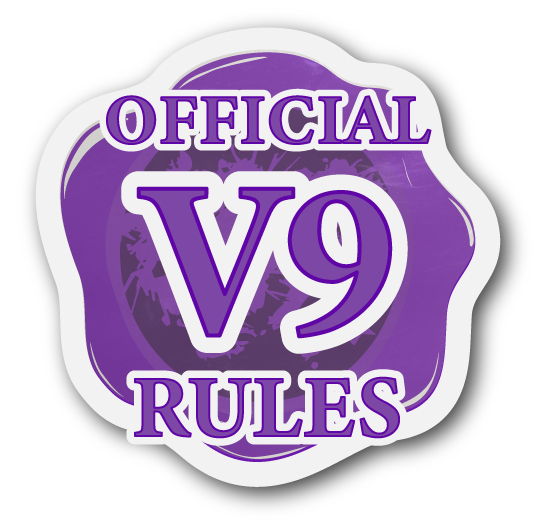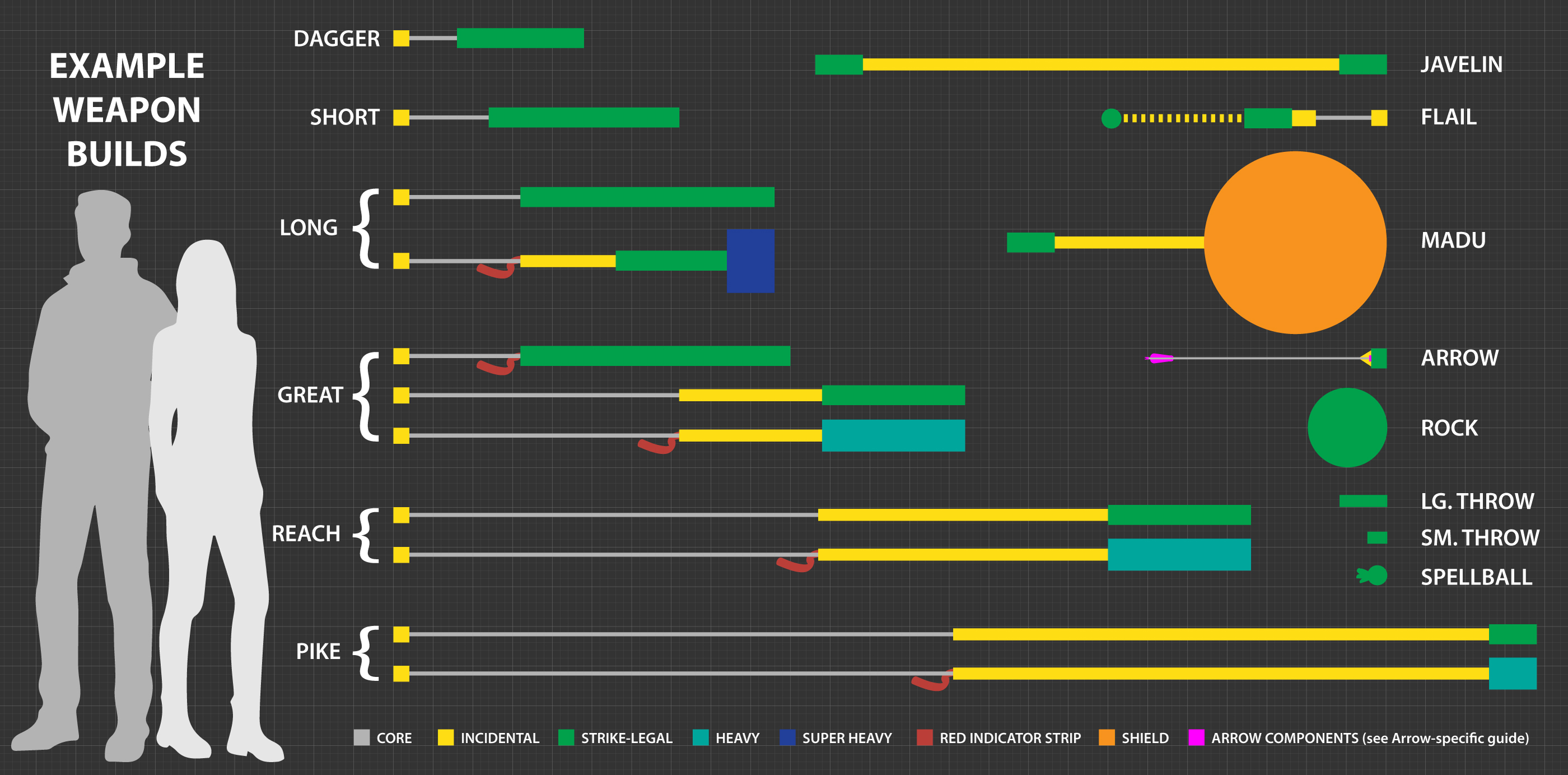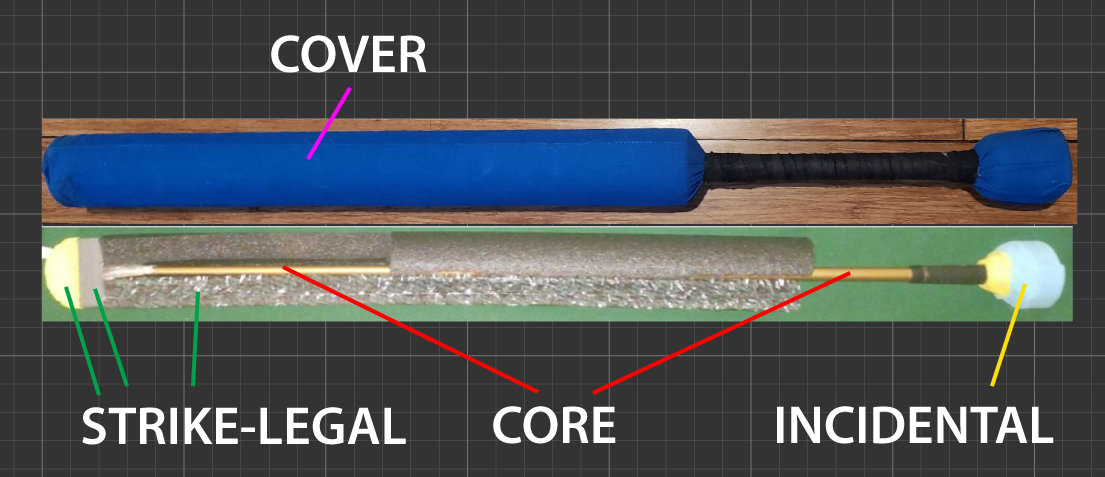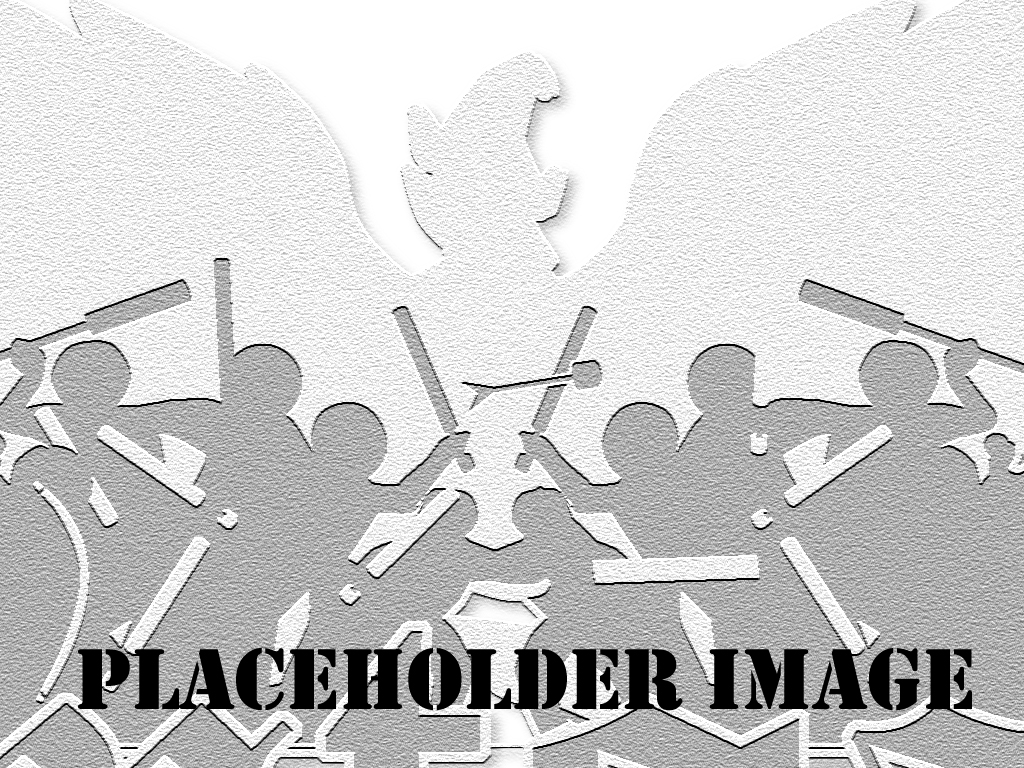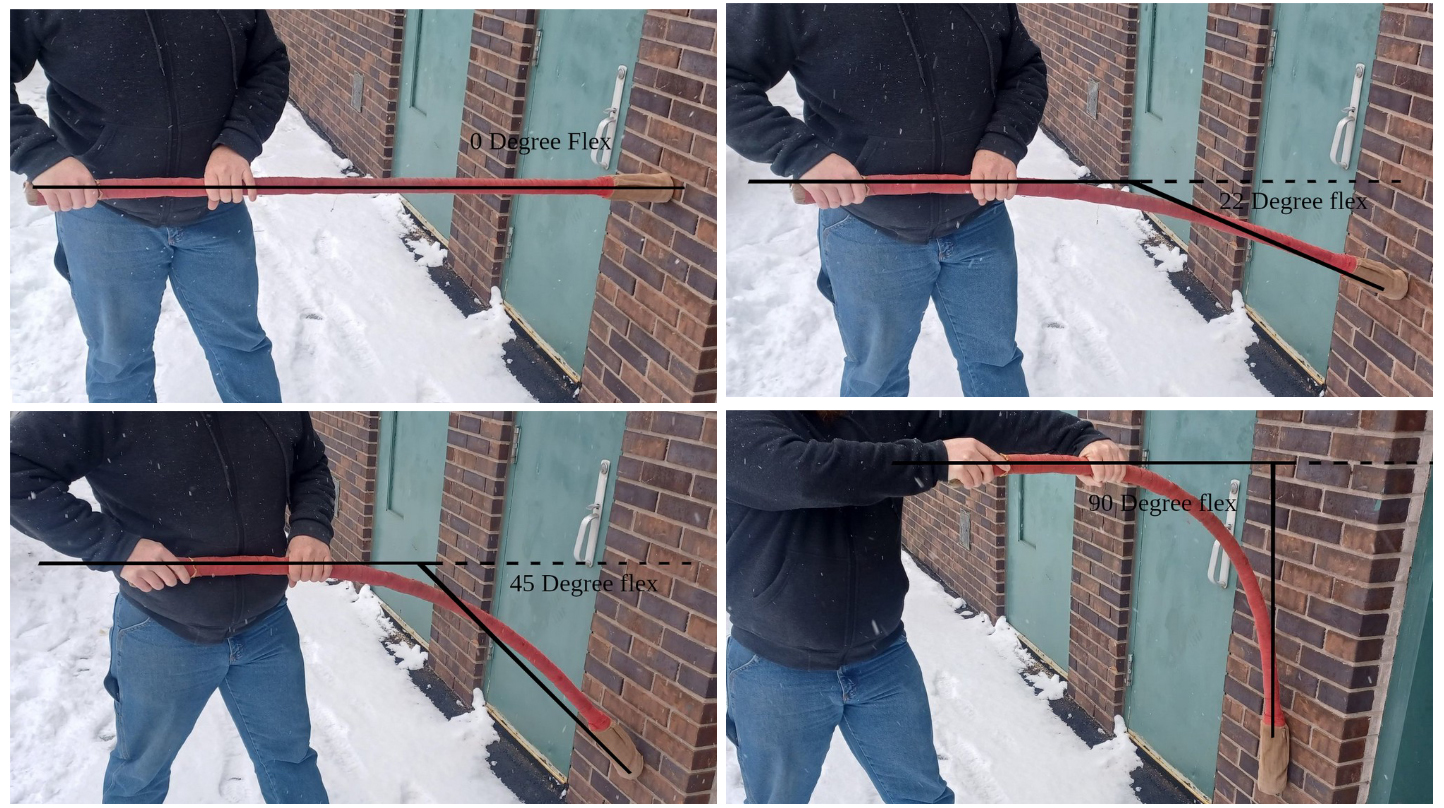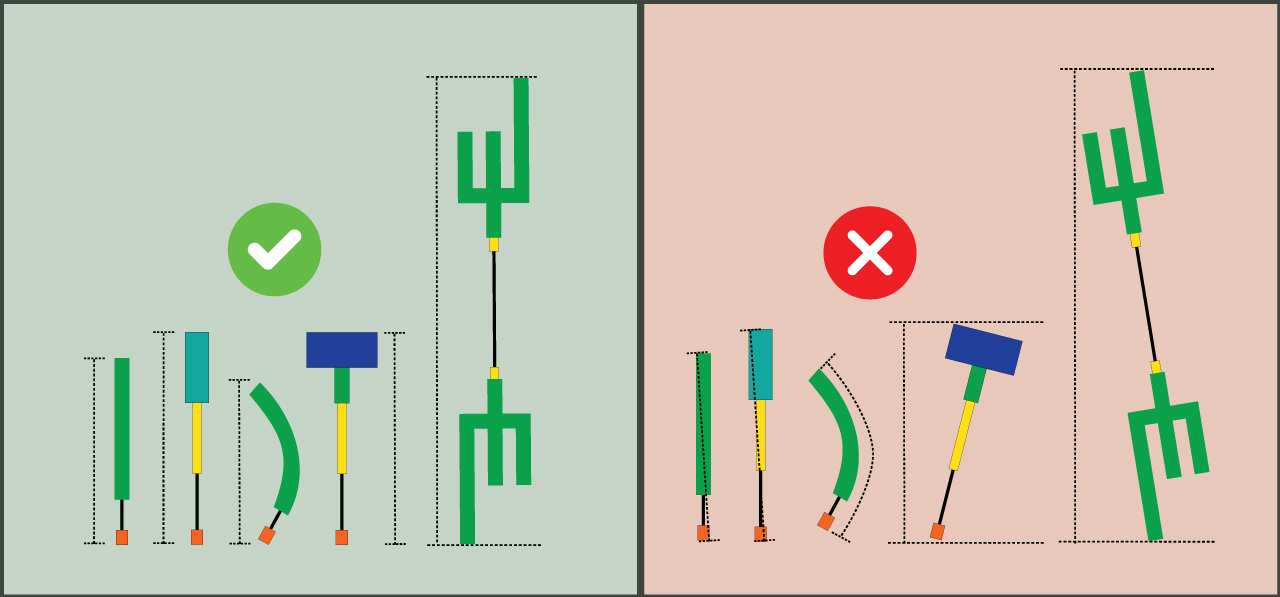V9: Weapon Construction Terms
- The Amtwiki is the official home and primary source for Amtgard V9 Rules as of February 25, 2023.
- These rules are currently in Open Alpha Playtest. See the Playtest Disclaimer for more details.
- To learn more about Amtgard V9 Development, please visit Amtgard.com.
- To view the current Amtgard V8 ruleset, please see the Amtgard V8 Rulebook.
Contents
- 1 Construction Terms
Construction Terms
Amtgard weapons are typically made from a structural core padded with foam and a cloth cover. Below is a diagram of a few typical weapons with their component parts labelled. You can read the descriptions for each component below, which are listed in alphabetical order for ease of reference.
2.5 Inch and 2 Inch Rule
- No part of a weapon's striking surface, whether the tip, the edge, the face or any other part, may protrude more than 1.5" through a two-and-a-half inch (2.5") ring when uncompressed.
- No part of a weapon or shield's non-striking surface such as the ends of crossguards or pommels may protrude more than 1.5" through a two-inch (2") ring when uncompressed.
Core
This refers to the structural base of the weapon to which padding is affixed.
- Rigid Cores
Melee Weapons require a rigid core to provide structural stability. Short weapon segments and small protrusions from a central core that are stable on their own do not require a rigid core within them. These segments and protrusions must not deform or fold over excessively during combat and must always return to their original position.- The best materials to use are carbon/graphite rods (such as from non-metallic golf clubs), kite spar, bamboo, PVC tubing, or fiberglass. Other materials will be assessed for safety on a case-by-case basis.
- Metal and wooden cores are prohibited. Metal may be used to counter-weight weapons provided it is permanently attached and not in a place that may inadvertently strike another player.
- The ends of any rigid cores should have a flat face and be securely capped with a layer of foam and tape at minimum to prevent the core from pushing through.
- Hollow cores should be sealed at the ends.
- Sharp edges should be blunted so as to not dig into the padding.
- Non-Rigid Cores
Contact Projectiles require a non-rigid, non-granunlar core.- The best materials to use are foam (any), denim, sweatshirt material, loose rubber bands, etc.
- Unacceptable cores include: Solid rubber, tightly-wrapped rubber bands, tennis balls, beanbags, seed packets, etc.
Covers
All striking surfaces must be covered in a durable, opaque cloth and be visually distinct from any non-striking surfaces. Incidental padding within 0.5" of a striking surface must also be covered in this manner. Non-abrasive cloth tape (not duct tape) may be used for Contact Projectiles but it is not an acceptable cover material for melee weapons or arrows.
Flex
This refers to how much a melee weapon can bend safely during normal use. Flex is measured by holding the weapon low on the handle for maximum length and striking a shield or padded surface. A second person can then estimate the flex.
- The maximum allowed flex for any weapon is 45 degrees.
Handle / Unpadded Segment
Refers to any completely unpadded part of a weapon.
- Unpadded segments cannot total more than 50% of the weapon.
- Surfaces that are likely to come into contact with other players during regular use cannot be left unpadded.
Incidental Padding
Incidental Padding, also known as 'Courtesy Padding', is a padded non-striking surface intended to limit injuries from incidental contact with parts that are not strike-legal.
- Must have at least 0.5" of safety-grade foam and provide enough cushioning to prevent any core from being felt during a typical strike, but it does not need to be as comfortable as strike-legal padding.
- Any portions of Incidental Padding that lies within 0.5" of a striking surface must be covered in the same manner as the adjacent strike-legal surface.
- Incidental Padding that is not within 0.5" of a striking surface may have a non-abrasive rubber coating (or non-vinyl equivalent) applied so long as it does not compromise the purpose of the padding by making it too firm.
Multi-Ended Weapons
Any melee weapon may have multiple segments and striking tips.
- Each segment that is intended to slash and stab must be Strike-Legal for at least 1/3 of the weapon's total length or 18", whichever is less, starting from the striking tip and moving continuously inwards. If the segment merges before the required amount is reached, the merged section that continues toward the handle counts for this total.
- Madu segments intended to stab and slash only require Strike-Legal padding for 1/3 of the weapon's total length or 12", whichever is less.
- Segments intended to be Stab-Only only require 6" of Strike-Legal padding.
- Segments must not be arranged in such a way that could create a high risk of a non-striking surface contacting a player when the weapon is used to strike normally. Any non-striking segments that are out of the way but could still reasonably come into contact with another player, such as crossguards, must be covered with Incidental Padding.
- If a weapon has both regular and stab-only segments, they must not be arranged in such a way that could risk a player being struck with the side of a stab-only segment when the weapon is used to slash.
- Multi-ended weapons must meet all other requirements for its weapon type.
Non-Striking Tip
This refers to the end of a non-striking weapon segment, such as a pommel or the end of crossguard. Weapon Segments with any amount of Strike-Legal padding cannot have a Non-Striking Tip.
- Must be securely capped with Incidental Padding.
- No part may protrude more than 1.5" through a 2" ring when uncompressed.
Ownership Label
All projectiles must be clearly labelled with their owner’s name. It does not need to be large or visible during combat but should be easy to find and reference when necessary, such as when a Reeve is trying to return a projectile that flew into a bush, or in the instance where that projectile causes injury to another player.
- Projectiles without ownership labels may not be used in combat.
- Weapons designed explicitly to be shared, such as park loaner weapons, should be labelled with the park’s name.
Padding and Foam
All Amtgard weapons and shields require some amount of padding to prevent player injuries. In this context, padding refers to either Strike-Legal Padding or Incidental Padding. The type required will determine which materials are acceptable to use for this purpose. If a piece of equipment simply requires "padding", "foam" or "cushioning" with no other description, then you can meet that padding requirement with either Strike-Legal or Incidental Padding.
Foam Grades
Foams can vary widely in terms of how they will act when used as padding so it is important to choose one that helps ensure your equipment will meet the universal equipment requirements - notably safety and durability. When in doubt, take the time to learn from an experienced player or study an online construction tutorial.
This rulebook may refer to two amtgard-defined categories of foam: Safety-grade and Comfort-grade.
Safety-Grade Foam
Safety-Grade Foams are sturdy and provide firm resistance to compression when tested with the pads of fingers, but are not rigid. The goal of Safety-Grade Foams is to provide the primary padding for weapons. Safety-Grade Foams should, when used in the specified thicknesses, prevent injuries and limit discomfort experienced by other players when they are struck with weapons during combat.
- Typical foams in this category include "blue camp pad", "pool noodle", and microcell foam.
Note: Safety-Grade foams sometimes come in multiple densities or stiffnesses and not all of them are safe for use on their own. Higher stiffness or density Safety-Grade Foams may not be suitable for use as the sole padding on a weapon but may improve the durability and striking comfort of a weapon when used as a base layer of foam closest to the core, with less stiff or dense Safety-Grade foam on top. Padding a weapon using multiple Safety-Grade Foams with different properties is referred to as building with "progressive resistance" or "progressive density".
Comfort-Grade Foam
Comfort-Grade Foams are squishy and less firm than Safety-Grade Foams while still being dense enough to provide some resistance to typical Amtgard weapon impacts. The goal of Comfort-Grade Foams is to provide greater shock absorption and further reduce discomfort from weapon impacts which may not be sufficiently mitigated by Safety-Grade Foams alone.
- Typical uses for Comfort-Grade Foams include additional padding on stabbing tips, arrows, and javelins.
- Comfort-Grade Foams should not be used on their own to pad a core.
- Typical foams in this category include "marine foam" and "high-density charcoal foam".
Extra Notes
- Very dense or rigid foam can be used as part of a structural core but it will not count towards any mandatory padding requirements. Polystyrene (hard TV packaging) is an example of a foam that is too rigid.
- Very soft and light foam can be used to add shape or extra comfort but will not count towards any mandatory padding requirements.
Stab-Only
Any segment of a weapon may be built to be Stab-Only.
- As the name implies, weapon segments built to be Stab-only can only be used to stab.
- A Stab-Only segment requires 6" of Strike-Legal Padding. This padding must begin at the Striking Tip and extend down the length of the weapon on all sides of the core (A stab-only segment must be Omni.)
- This padding cannot be reduced by Heavy Padding or Super Heavy Padding.
- A weapon that is composed entirely of Stab-Only segments can replace all other Strike-Legal Padding required by its type with Incidental Padding.
- A weapon with both regular and stab-only segments must still meet the full padding requirements for its type.
- If a weapon has both regular and stab-only segments, they must not be arranged in such a way that could risk a player being struck with the side of a stab-only segment when the weapon is used to slash.
Strike-Legal Padding
Strike-Legal Padding is padding that is used to create striking surfaces that are safe to strike another player with.
- Weapons that require Strike-Legal Padding must be sufficiently padded to prevent injury if used to strike an opponent with the most force that could reasonably be expected in Amtgard combat. Combat contact with the strike-legal portions of a weapon must not be unreasonably painful, nor should it leave bruises or have the potential to break bones and teeth when used by an average player as well as its intended user.
- Regardless of the requirements listed below, Hit Testing will always be required to assess the more subjective aspects of Strike-Legal padding, such as impact force and player comfort.
- Since combat is chaotic and every participant has different pain tolerances and sensitive areas, occasional instances of uncomfortable contact should be expected, however repeated or egregious offenses from the same weapon should result in the weapon and/or the user being removed from play.
- No part of the weapon’s striking surface, whether the tip, the edge, the face or any other part, may protrude more than 1.5" through a two-and-a-half inch (2.5") ring when uncompressed.
- All Strike-Legal surfaces must have an opaque cover and be visually distinct from Non-Striking Surfaces on the same weapon.
Melee Strike Legal
In addition to the above, Strike-Legal padding on melee weapons must follow these additional rules:
- Strike-Legal Padding must begin at each Striking Tip and move inward along the core toward the handle. It must be continuous for the entire required length. Any forked segments that split from a Strike-Legal point must also be entirely Strike-Legal.
- Must have at least 1" of safety-grade foam over the weapon core.
- Must have a continuous cross-section of at least 2.5" from edge to edge.
- The entire circumference of the core does not need to be strike-legal, however any part of this circumference that is not strike-legal must be covered with Incidental Padding and cannot be used to strike.
- Striking Tips must be sufficiently capped to resist stab impact and prevent the core from pushing through. The foam should not deflect or fold over excessively when stabbing and always return to its original position.
- It is strongly recommended that weapons intended to regularly strike with a thrusting motion also include comfort-grade foam on the tip to further cushion the blow. Weapons designed for two-handed stabs, such as large pikes, may need even more padding than smaller, single-handed weapons. Hit Testing will help determine what is the ideal amount of extra padding for player safety and comfort.
Heavy Padding
A segment of a melee weapon is considered to have Heavy Padding if it meets the requirements for Strike-Legal padding and also has an edge-to-edge, cross-section of 4" or greater (instead of 2.5"). This extra padding must begin within 3" of the Striking Tip and proceed continuously towards the handle.
- Heavy Padding can apply to flat-blade weapons. The 4" cross-section does not need to be around the entire core.
Heavy Padding Substitution
For each inch of Heavy Padding added along the core, you may replace one (1) inch of required Strike-Legal Padding with Incidental Padding.
- Incidental Padding added in this manner must begin by replacing the padding closest to the handle and then proceed continuously towards the Striking Tip.
- A weapon cannot substitute more than 50% of its required Strike-Legal padding this way.
Super Heavy Padding
Super Heavy Padding follows the same rules as Heavy Padding except it requires a cross-section of 8" or greater. If both Heavy and Super Heavy padding are used together, the Super Heavy Padding must be closest to the tip.
Super Heavy Padding Substitution
This follows the same rules as Heavy Padding Substitution except for each inch of Super Heavy Padding added along the core, you may replace two (2) inches of required Strike-Legal Padding with Incidental Padding.
Striking Tip
The tip of any weapon segment that will be used to strike other players. All Striking Tips must have Strike-Legal padding.
- Must not protrude more than 1.5" through a two-and-a-half inch (2.5") ring when uncompressed.
- Must not end in an angle less than 90 degrees.
Total Length
The measurement used to determine weapon type.
- Straight weapons are measured in a straight line parallel to the core, from the furthest edge on one end to the furthest edge on the other end.
- All other weapons are measured by the largest straight distance between any two ends or edges.
Weapon Segments
A weapon segment is a portion of a melee weapon. Segments begin at the handle (or the shield, for Madus) and end at a striking or non-striking tip.
- Striking segments are segments that end with a Striking Tip.
- Non-Striking segments are segments that ends with a Non-Striking Tip.
- Segments may also branch or split to create new segments (like a trident or crossguard). These branching segments must meet or exceed the padding requirements of the point they branched out from. For example, if a segment branches out from a point that requires Strike-Legal padding then the entirety of that branched segment must also be Strike-Legal.
Identifying weapons segments is most relevant when dealing with Madus, Multi-Ended Weapons, and Stab-Only weapons.
Weapons General Rules · Weapon Construction Terms · Melee Weapons · Projectile Weapons · Siege Weapons
Equipment Equipment Basics · Equipment Use Terms · Weapons · Shields · Armor · Color Code · Visual Indicators
